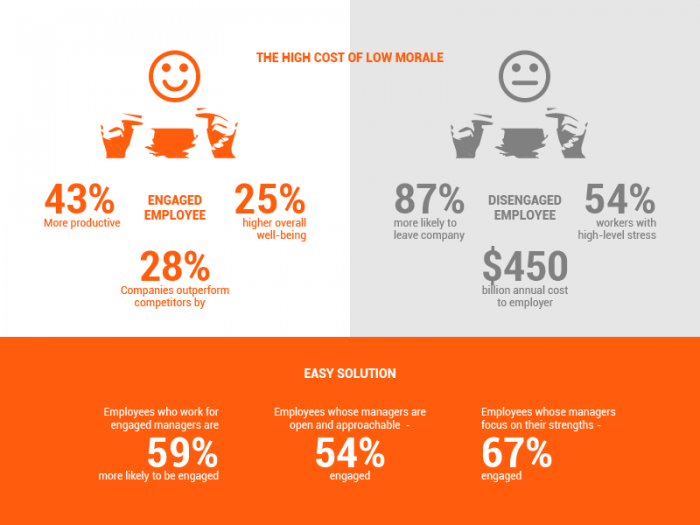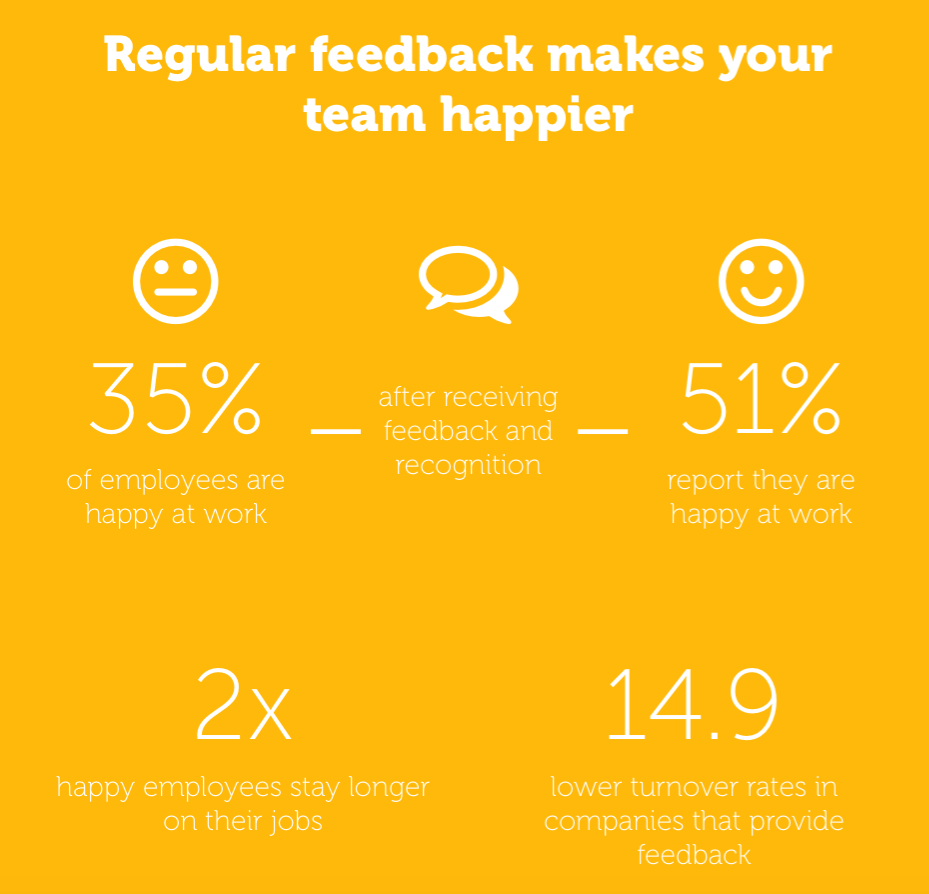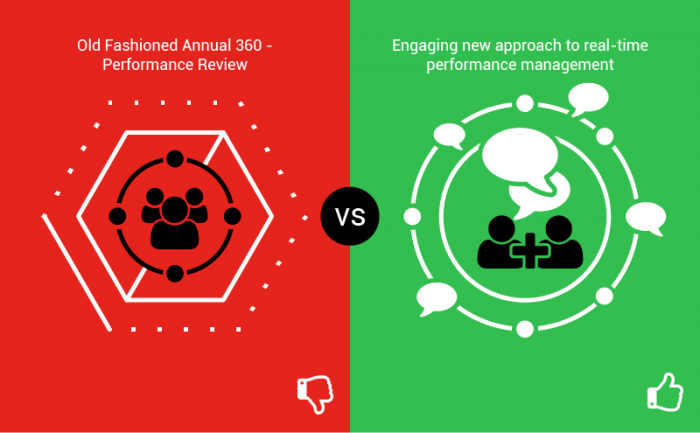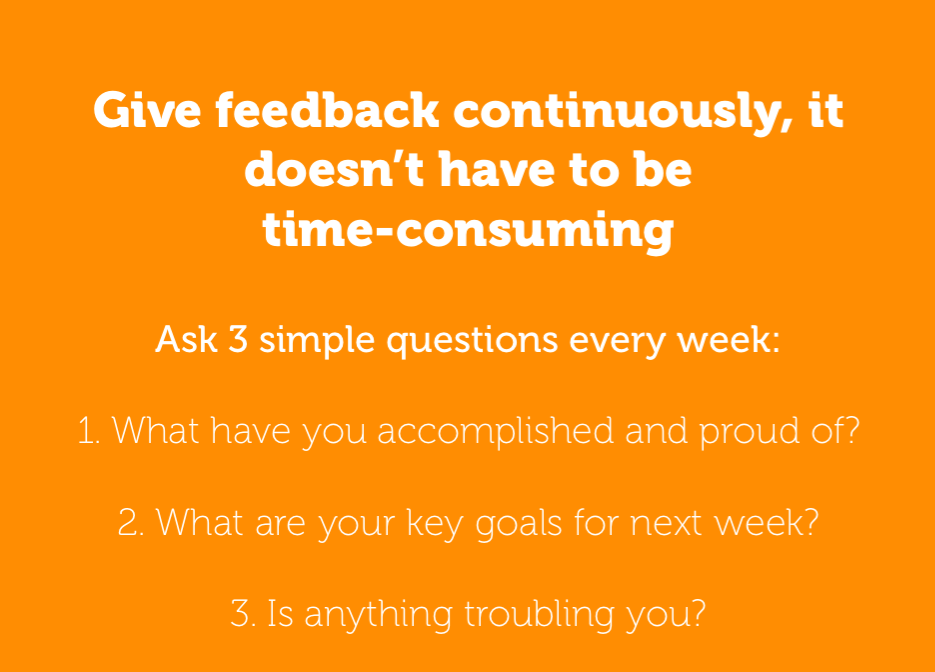One of the more overlooked tools at team managers’ disposal is feedback, taken from employee progress reports. Quite often, it presents a make-or-break situation. When done right, feedback can greatly improve engagement and productivity and boost team spirit. Do it too sloppily, however, and you will end up doing more harm than good.
Why take the risk, then?
Again, all in the name of productivity.
According to our survey, 53% of leader think regular weekly feedback is very important and 33% think it’s important. And they are right. Considering, that only about 30% of employees in the USA are engaged, having a team like that is a enormous advantage over your competitors.

When employees start getting feedback, they feel they are part of the company. Employee recognition plays a huge part in boosting performance and maintaining high levels of engagement. It is also one of manager’s best tools and an important part of organizational communication.When done regularly, feedback stops being a thing to be anxious about and becomes another part of your work.
What is the the employee feedback cycle?
Employee feedback progress consists of 3 parts for the manager:
- understanding what employee is doing;
- offering feedback;
- receiving feedback.
Understanding employees work-process
For the purposes of employee feedback, it’s important to have a clear overview about what everyone is your team is doing.
You can use weekly status reporting software to get a good overview about everything your team is doing. Weekly status reporting is not only the most painless form of employee management but it also offers a chance to give instant employee feedback with weekly review or like/comment functionality that is familiar to everyone using social media.
Giving employee feedback
Employees need regular feedback. So you can’t just depend on yearly or quarterly feedback when managing people in your company.
If you’re running bigger team’s or departments, it may seem that giving weekly feedback wastes a lot of time. But feedback doesn’t have to come as a 1-on-1 meeting or in some other time consuming form. Employee feedback can be given with two sentences or with a simple pushing of the “Like” button that let’s employees know that you are aware of what they are doing and you approve.
Receiving employee feedback
Company communications should always be a two-way street. In addition to telling employees what to do, you must also give them a chance to offer suggestions on how you and your company can help them do their work.
If you still want to use employee 1-on-1 meetings as a feedback tool, you can take a look at this presentation. Employee feedback is a powerful way to influence employees and make sure everyone in your team is doing what is expected of them.
But to reap the most benefits, feedback must be done right. Otherwise you may discover that it brings in very few results while taking tremendous amounts of time. If this sounds like a good deal to you and you want to start providing feedback to your employees, learn these next rules by heart.
The 5 Rules of Employee Feedback
#1 Be specific
First of all, employee feedback should always relate to a specific goal. Establish your expectations beforehand so you know what to focus on when it’s time to provide feedback. Take pains to explain how a certain employee contributes to that goal.
When reviewing their work, use numbers and data. Embrace the metrics. Find all the evidence to support your opinion, otherwise, there’s little value in it. Be specific about what was done and what wasn’t.
Jamie Resker, performance management thought leader, proposed that you should always include the following in your feedback: general statement, specific example, and the positive impact. Strive to answer the questions “what was done right” and “what can be improved”.
#2 Be relevant
Secondly, you should provide feedback to your employees in a timely manner, so that your comments would be relevant and your employees could make an improvement to their performance. The sooner you communicate some of the challenges and problems, the sooner they will look into it.
You should not be stingy with your feedback, either. Paul Falcone, the author of 2600 Phrases for Effective Performance Reviews, says that employee evaluations should be happening throughout the year. Here’s the mindset Falcone uses to back this up:
“How much do you value me as an employee if out of the 2,080 hours I work, and—Lord knows it’s more than that—you only give me one review? It’s just not enough.”
#3 Be constructive
Keep in mind the basic human psychology. People respond better to positive information, so always open your feedback with praise and then continue with constructive comments. In no way does this mean you have to sugar-coat your opinion, but there is a reason we still use the idiom “take the bitter with the sweet”.
Not wanting to be too negative is a commendable thing. But you have to keep in mind that, according to Gallup study, employees who get predominantly negative feedback are 20 times more likely to be engaged than those who get no feedback at all.
That is not to say that you should be caustic, only that the lack of employee feedback does the bigger damage here.
Make it clear what the employee did right and offer your suggestions, as constant criticism rarely leads to constructive changes. Don’t expect others to learn how to read your mind. Be explicit in your suggestions.
#4 Be willing to learn
Never forget that feedback is a two-way communication. Your suggestions, like any other opinion, can be right or wrong. Provide a chance for discussion. Show that you are as willing to listen as you are to share your opinion.
Getting feedback to your feedback may sound silly at first, but we never get better by ourselves. We always need a new perspective to assess things objectively. Take note of what kind of feedback works and what doesn’t.
As a rule of thumb, good managers are good listeners as well. Need a hand? Lend an ear.
#5 Be aware of technology
When we talk about the benefits of feedback, we talk from years of experience. There is a reason Weekdone made employee feedback the cornerstone of its app. We believe that no performance report is truly complete without a well-put comment after it. To this end, we provide you with the best tools to express yourself.
Feedback in Weekdone can be as simple as giving a like under a certain action and as detailed as leaving a personal comment. Our templates, which are divided into three categories (Ask, Praise, and Concerns), allow quick access to standard sentences.
Moreover, Weekdone helps you automate weekly status report notifications and communicate to the whole team and company. You can also customize the employee progress report to fit your needs.
If you want better results, work on your feedback.


